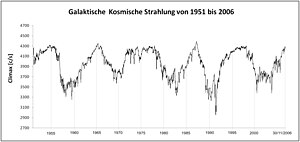Anthony Watts gives an update on its progress on his blog Watts Up With That.
From Nature blog: Sunny days for CLOUD experiment
An experiment designed to investigate the link between solar activity and the climate has its first results in the bag. At the American Geophysical Union meeting in San Francisco today, Joachim Curtius presented data from the first runs of the CLOUD (‘cosmics leaving outdoor droplets’) experiment at CERN – the European particle physics lab outside of Geneva.
The experiment has a long and bumpy history. The idea is to test the theory that cosmic rays spur the formation of particles in the air that nucleate clouds, in turn making skies cloudier and the planet cooler. Researchers have noted a dearth of sunspots (which is linked to more cosmic rays) during the ‘little ice age’ of the seventeenth and eighteenth centuries, and a peak in sunspots (linked to a drop in cosmic rays) during the late 1980s, when global cloudiness dropped by about 3% (see Nature‘s feature on the project). No one knows how big this effect might be, and the idea that it might account for a big chunk of the warming over the last century is highly controversial.
CLOUD uses a particle beam from CERN as a stand-in for cosmic rays, and fires them through an ultra-clean steel chamber filled with select atmospheric gases, to see if and how particles that could nucleate clouds are formed. Project head Jasper Kirkby proposed the experiment back in 1998. But it had a hard time getting off the ground – perhaps in part because Kirkby received bad press for emphasizing the importance of cosmic rays to climate change (see this story from the National Post). CLOUD finally got going in 2006, and they started work with the full kit in November 2009 (here’s a CERN video update about that).
The results haven’t yet been published, so Curtius declined to discuss the details. But the important thing is that the project is working – they have seen sulphuric acid and water combine to make particles when blasted by the CERN beam, for example, in a way that matches predictions of the most recent models. The data should help the team to quantify how much of an impact the Sun is having on climate within 2-3 years, Curtius says – though there are a lot more pieces of the puzzle to fill in.
============================================================

Dr. Roy Spencer has mentioned that it doesn’t take much in the way of cloud cover changes to add up to the “global warming signal” that has been observed. He writes in The Great Global Warming Blunder:
The most obvious way for warming to be caused naturally is for small, natural fluctuations in the circulation patterns of the atmosphere and ocean to result in a 1% or 2% decrease in global cloud cover. Clouds are the Earth’s sunshade, and if cloud cover changes for any reason, you have global warming — or global cooling.
This graph certainly lends credence to the theory:
Here’s a longer record of cosmic rays:
See also these WUWT stories:
Something to be thankful for! At last: Cosmic rays linked to rapid mid-latitude cloud changes
Message in the CLOUD for Warmists: The end is near?













![cosmic_rays_hit_earth[1]](http://wattsupwiththat.files.wordpress.com/2010/12/cosmic_rays_hit_earth1.jpg?w=400&h=320)


No comments:
Post a Comment